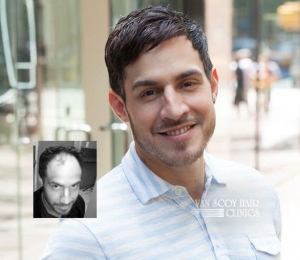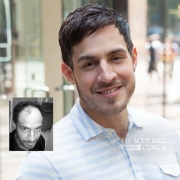Addressing Thinning Hair & Hair Loss in Men & Women
Hair loss is a common concern for both men and women. It can have a significant impact on self-esteem and confidence. Fortunately, advancements in hair restoration technology have made it possible to address hair loss effectively. One such solution is hair replacement systems. These systems provide a natural-looking and long-lasting solution for individuals experiencing hair loss. In this article, we will explore how hair replacement systems work and how they can help men and women regain their confidence.
What is a Hair Replacement System?
 Hair replacement systems are custom-made solutions that are designed to mimic the appearance of natural hair. Hair replacement systems are created using either human or synthetic hair, which is hand-woven onto a base material such as lace or polymers. The base is then attached to the individual’s scalp using tape or adhesive and carefully cut and blended to perfectly match the individual’s own hair, making it virtually undetectable.
Hair replacement systems are custom-made solutions that are designed to mimic the appearance of natural hair. Hair replacement systems are created using either human or synthetic hair, which is hand-woven onto a base material such as lace or polymers. The base is then attached to the individual’s scalp using tape or adhesive and carefully cut and blended to perfectly match the individual’s own hair, making it virtually undetectable.
Types of Base Materials
Hair replacement systems can be constructed using different base materials, each offering its own set of advantages and disadvantages.
- Mesh Fabric: Mesh fabric, typically made of polyester or nylon, is commonly used to build the hairline of a hair replacement system. It provides a natural and lifelike appearance. However, mesh fabric is not as durable and needs to be replaced more frequently.
- “Skin base” units are typically made from polymers, are generally transparent, and allow the individual’s scalp to be seen through the base, thereby making it appear that the added hair is actually growing from the person’s own scalp. Lace units, as described above, also have this ability.
The hair used in a hair replacement system is customized to match the individual’s hair color, texture, natural curl or wave, and density. This ensures a seamless blend with the individual’s existing hair, resulting in a natural and undetectable appearance. The customization process involves selecting the right color, texture, and length of the hair to create a perfect match. It’s important to consult with a hair restoration professional to determine the most suitable base material for your needs and lifestyle.
Benefits of Hair Replacement Systems
Hair replacement systems offer several benefits for individuals dealing with hair loss. Let’s explore some of the key advantages:
One of the primary benefits of hair replacement systems is their ability to provide a natural and realistic appearance. The customization of the hair color, texture, and length ensures that the hair replacement system seamlessly blends with the individual’s existing hair. This natural look helps individuals regain their confidence and feel comfortable in their own skin.
Hair replacement systems allow individuals to style their hair just like they would with their natural hair. Whether it’s cutting, coloring, or styling, individuals have the freedom to experiment with different looks and maintain their desired hairstyle. This versatility in styling ensures that individuals can express their personal style and feel confident in their appearance.
Long-Lasting Solution
Hair replacement systems are designed to be long-lasting. With proper monthly care and maintenance, they can provide a durable solution for individuals experiencing hair loss. The durability of these systems allows individuals to go about their daily activities without worrying about their system coming off or getting damaged. Typically, hair replacement systems need service on a 4-5 week schedule, much like your own hair needs service on a monthly basis to keep it looking fresh and healthy. Depending on the actual construction of your hair replacement system, they typically have a useable life cycle of approximately three months, after which time we replace it with a new unit.
Non-Invasive and Safe
Non-surgical hair replacement systems are non-invasive. This makes them a safe and accessible option for individuals who may not be suitable candidates for hair transplant surgery or prefer a non-surgical solution. Customizable and Personalized
Hair replacement systems are highly customizable and can be tailored to meet the specific needs and preferences of each individual. From the choice of base material to the color, texture, and length of the hair, every aspect of the system can be personalized to ensure a perfect match and a natural look. This customization allows individuals to achieve their desired aesthetic outcome and enhances their overall satisfaction with the system.
Getting a Hair Replacement System
Getting a hair replacement system involves several steps to ensure a seamless and successful outcome. Let’s walk through the typical process:
- Consultation: The first step is to schedule a consultation with a hair restoration professional. During this consultation, the professional will assess your hair loss condition, discuss your goals and expectations, and recommend the most suitable hair replacement system for you.
- Customization: Once you have decided to proceed with a hair replacement system, the next step is customization. This involves selecting the base material, color, texture, and length of the hair to create a system that matches your natural hair seamlessly.
- Fitting and Styling: After the hair replacement system is customized, it is time for the fitting and styling process. Once your hair replacement system is attached, we cut and style the hair to achieve your desired look. This step allows you to personalize the system and make it your own.
- Maintenance and Care: Proper maintenance and care are essential to ensure the longevity and optimal performance of your hair replacement system. We will go over with you what you need to do in terms of cleaning, daily style, and normal care for your system to keep it looking its best.
Other Hair Loss Solutions
While hair replacement systems are a popular and effective solution for hair loss, there are other options available for individuals experiencing hair loss. These include:
Hair transplantation is a surgical procedure that involves harvesting healthy hair follicles from one part of the body (typically the back or sides of the scalp) and transplanting them to areas experiencing hair loss. This procedure provides a permanent solution and can result in natural-looking hair growth. However, it is a more invasive procedure and may not be suitable for everyone.
Topical treatments and medications, such as minoxidil and finasteride, can help slow down or prevent further hair loss in some cases. These treatments are typically applied directly to the scalp and work by stimulating hair growth and preventing the shrinking of hair follicles. However, they may not be effective for everyone and require long-term use to maintain results.
Laser hair therapy is a non-invasive treatment option for hair loss that uses low-level laser light to stimulate hair growth. This therapy is thought to increase blood flow to the hair follicles, promoting hair growth and improving the overall health of the scalp. Laser therapy can be used in combination with other hair loss treatments for enhanced results.
Van Scoy Hair Clinics Across Ohio
Hair replacement systems have revolutionized the way individuals with hair loss can regain their confidence and achieve a natural-looking appearance. With their customizable nature, long-lasting durability, and versatility in styling, these systems provide an effective solution for both men and women experiencing hair loss. If you are considering non-surgical hair replacement system, we invite you to schedule a free, private consultation at a Van Scoy Hair Clinic location near you. We will answer all your questions and help you find the best solution for your needs. Remember, regaining your hair means regaining your confidence and embracing your true self.



 Hair Transplant Surgery: A Timeline
Hair Transplant Surgery: A Timeline



